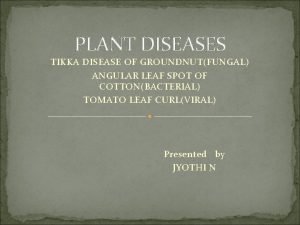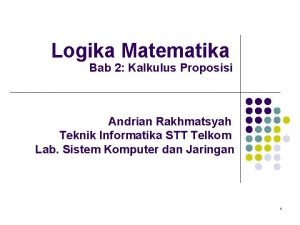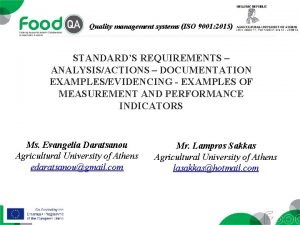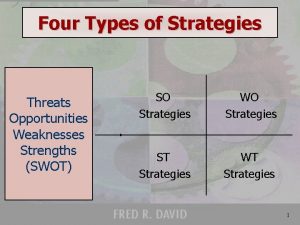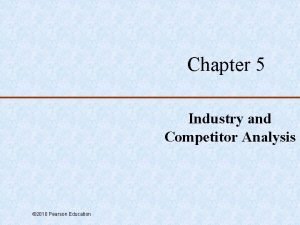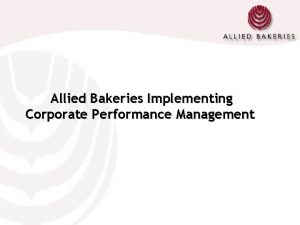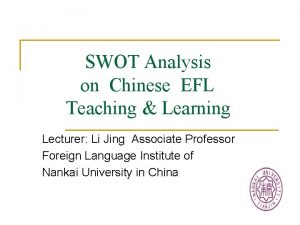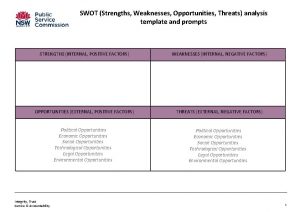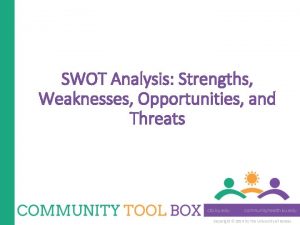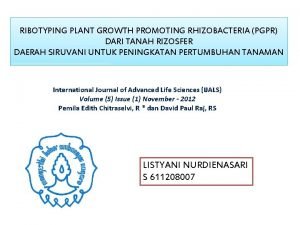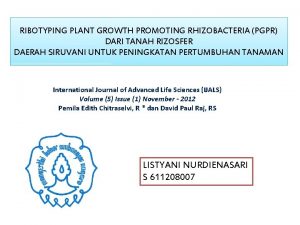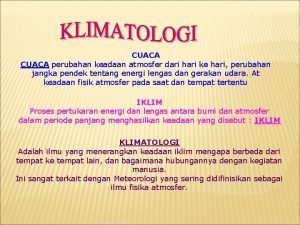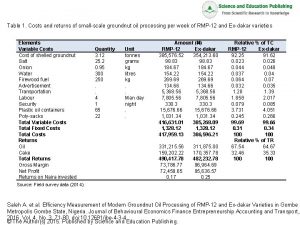PGPR in Groundnut Opportunities and Challenges Hari K





















- Slides: 21

PGPR in Groundnut: Opportunities and Challenges Hari K. Sudini 1, C. L. L. Gowda 1, and M. S. Reddy 2 1. International Crops Research Institute for the Semi Arid Tropics, India 2. Department of Entomology and Plant Pathology, Auburn University, USA

Top five producers of Groundnut and their important constraints Countries Biotic constraints Abiotic constraints PR China Bacterial wilt, Leaf spots, Stem rot Drought, temperature India Stem rot, Leaf spots, GBNV, TSV Drought, temperature, soil p. H USA TSWV, RKN, White mold, Water and heat stresses Leaf spots (ELS/LLS) Nigeria Leaf spots, GRV Drought, temperature Indonesia Leaf spots, stem rot Drought, temperature A. flavus infection and subsequent aflatoxin contamination is a worldwide qualitative issue

PGPR Growth Promotion Mechanisms in Groundnut Direct Production of plant growth regulators (Kishore et al. , 2005, Dey et al. 2004) Nitrogen fixation (NPR, Kloepper et al. , 1991) Uptake of minerals (Increase in available P, Dey et al 2004) Root colonization (Kishore et al. 2005) Indirect Prevent the deleterious effect of phytopathogens (Anjaiah et al. 2006, Abd-Allah and El Didamony 2007) ISR (Priming) Positive-Maria Laura Tonelli et al. 2011 Negative-Zhang et al. 2001

Groundnut PGPR Research @ ICRISAT üBiocontrol-PGPR üPre-harvest aflatoxin contamination in Groundnut • fluorescent Pseudomonads and Bacillus strains (Anjaiah et al. , 2006) üLate leaf spot management • Chitinolytic bacteria (Kishore et al. , 2005) • Chlorothalonil-tolerant endophytic isolates of Pseudomonas aeruginosa (Kishore et al. , 2005) üCollar rot disease management • Pseudomonas aeruginosa GSE 18 (Kishore et al. , 2005)

Opportunities/Thrust areas for Groundnut PGPR Research Microbial Ecology-PGPR Metagenomics-PGPR Climate Change-PGPR §Low-input agricultural production systems §Intensive agricultural production systems BNF §Interaction of Rhizobial and PGPR strains

Microbial Ecology-PGPR Cultivation practices Soil type PGPR communities Plant community structure

Methods to assess PGPR community structure and diversity Low-resolution techniques Intermediate-resolution § Community-level § Bacterial counts/plating methods physiological profiling (CLPP) § Phospholipid fatty acid analysis (PLFA) § Microbial biomass measurements § Fatty acid methyl ester analysis (FAME) § DGGE/TGGE § SSCP § T-RFLP High-resolution §RISA/ARISA §ARDRA & T-ARDRA §Cloning & Sequencing §Metagenomics §Taxonomic microarrays These techniques have their own limitations but the information obtained from complex environmental samples is more important.

Microbial Ecology in Groundnut Ecosystems with reference to PGPR §Soil genomic DNA from rhizosphere samples §PCR amplification with universal bacterial specific primers (ITSF & ITSR eub) §PCR amplicons were run on the NEN Global Edition Li-Cor 4300 DNA Sequencer §Results §Similarities up to (90%) between profiles of same cropping sequence §Time of sampling has more profound effect on bacterial community groupings §Similarities and dissimilarities are attributed to crop diversity and time of sampling Phytopathology. 2011 Jul; 101(7): 819 -27. Exploring soil bacterial communities in different peanut-cropping sequences using multiple molecular approaches. Sudini H, Liles MR, Arias CR, Bowen KL, Huettel RN.

Microbial Ecology in Groundnut Ecosystems with reference to PGPR PCR-Cloning and Sequencing 16 S r. RNA library construction §PCR amplification of genomic DNA §Universal bacterial primers (27 F and 1492 R) §PCR product purification by Centrifugation (Wizard SV Gel and PCR Clean-Up System) §Ligated into a TOPO-TA p. CR 2. 1 vector §Transformation into E. coli and were grown on LB agar plates containing 25 microgram per ml kanamycin

Microbial Ecology in Groundnut Ecosystems with reference to PGPR 16 S r. RNA gene Sequencing § 288 different r. RNA genes from each soil sample were sequenced using Rolling Circle Amplification of plasmid DNA and unidirectional sequencing with a vector primer (Symbio Corp. , CA) §Divisional level allocation was annotated based upon BLASTn analysis with the nr/nt Gen. Bank database

PGPR Ecology Divisional level affiliation of bacterial groups in Groundnut ecosystems (Sudini et al. , 2011) 16 32 Proteobacteria 7. 5 Acidobacteria Firmicutes Bacteroidetes 7. 7 Actinomycetes others 13. 8 23

PGPR Ecology Bacterial divisions in peanut rotation sequences (Sudini et al. , 2011)

PGPR Ecology Correlations between bacterial divisions (Sudini et al. , 2011) 70 Verrucomicrobia 14 60 12 50 10 40 8 Firmicutes 30 6 20 4 10 2 0 0 20 40 60 Proteobacteria 80 100 0 0 5 10 15 20 Actinobacteria 25 30

Metagenomics-PGPR ØAdvances in ØEnvironmental DNA extraction protocols ØMetagenomic library construction ØHigh-throughput sequencing methods ØPossible contributions to PGPR ØThe discovery of novel PGPR genes and gene products ØThe characterization of not-yet cultivable PGPRs Susannah Green Tringe and Edward M. Rubin, 2005

Expected benefits with reference to Groundnut rhizosphere PGPR Identify biologically different PGPR communities associated with Groundnut ecosystems Insights into “inaccessible” PGPR Factors responsible for disease suppressive soils

Climate Change-PGPR §Increased burden of arid and semi-arid land areas §Elevated temperature, CO 2, Erratic weather, floods, droughts §PGPR could be a viable option §Concept proved in model plant Arabidopsis (Cohen et al. , 2008) §Induction of plant tolerance to semi-arid environments §Stress relievers-PGPR

PGPR modify plant hormonal contents in order to increase drought tolerance R. Aroca and J. M. Ruiz-Lozano, 2009

Interaction of Rhizobial and PGPR strains §Important area of research §Co-inoculation (PGPR strains + Rhizobia) §Nodulation promoting rhizobacteria (NPR, Kloepper et al. , 1991) §Growth enhancement (Madhaiyan et al 2006, Vikram et al 2007) §Exact mechanisms still need to be explored

Challenges for Groundnut PGPR Research §Contradictory reports on Induced Systemic Resistance §Interaction between associative PGPR and Groundnut unstable §Reproducibility obstacles between in vitro and field studies §Influence of environmental factors

Way Forward/Future Research ØBetter understanding of Plant-PGPR interactions ØInsight into PGPR mode of actions and adaptability to extreme environmental conditions ØWays and means for better utilization of PGPR in the farmers fields ØPGPR & Omics approaches ØTranslational Research on PGPR: From “Omics to the Field”

Thank you
 Opportunities of media and information in political
Opportunities of media and information in political Groundnut sowing
Groundnut sowing Legume
Legume Greater bay area opportunities and challenges
Greater bay area opportunities and challenges Tikka disease of groundnut symptoms
Tikka disease of groundnut symptoms P hari ini hujan q hari ini anginnya kencang
P hari ini hujan q hari ini anginnya kencang Menarilah dan terus tertawa
Menarilah dan terus tertawa Hidangan kesempatan khusus untuk acara adat istiadat
Hidangan kesempatan khusus untuk acara adat istiadat Actions to address risks and opportunities
Actions to address risks and opportunities List of opportunities and threats
List of opportunities and threats Competitor grid
Competitor grid New entry entrepreneurship
New entry entrepreneurship Trends and opportunities examples
Trends and opportunities examples Factbranch
Factbranch Swot analysis of a teacher
Swot analysis of a teacher Swot analysis example for teachers
Swot analysis example for teachers An opportunity has four essential qualities it is
An opportunity has four essential qualities it is Career opportunities in biotechnology and drug development
Career opportunities in biotechnology and drug development Recognizing opportunities and generating ideas
Recognizing opportunities and generating ideas Strengths weaknesses opportunities and threats template
Strengths weaknesses opportunities and threats template List of opportunities and threats
List of opportunities and threats Spouse education and career opportunities
Spouse education and career opportunities




